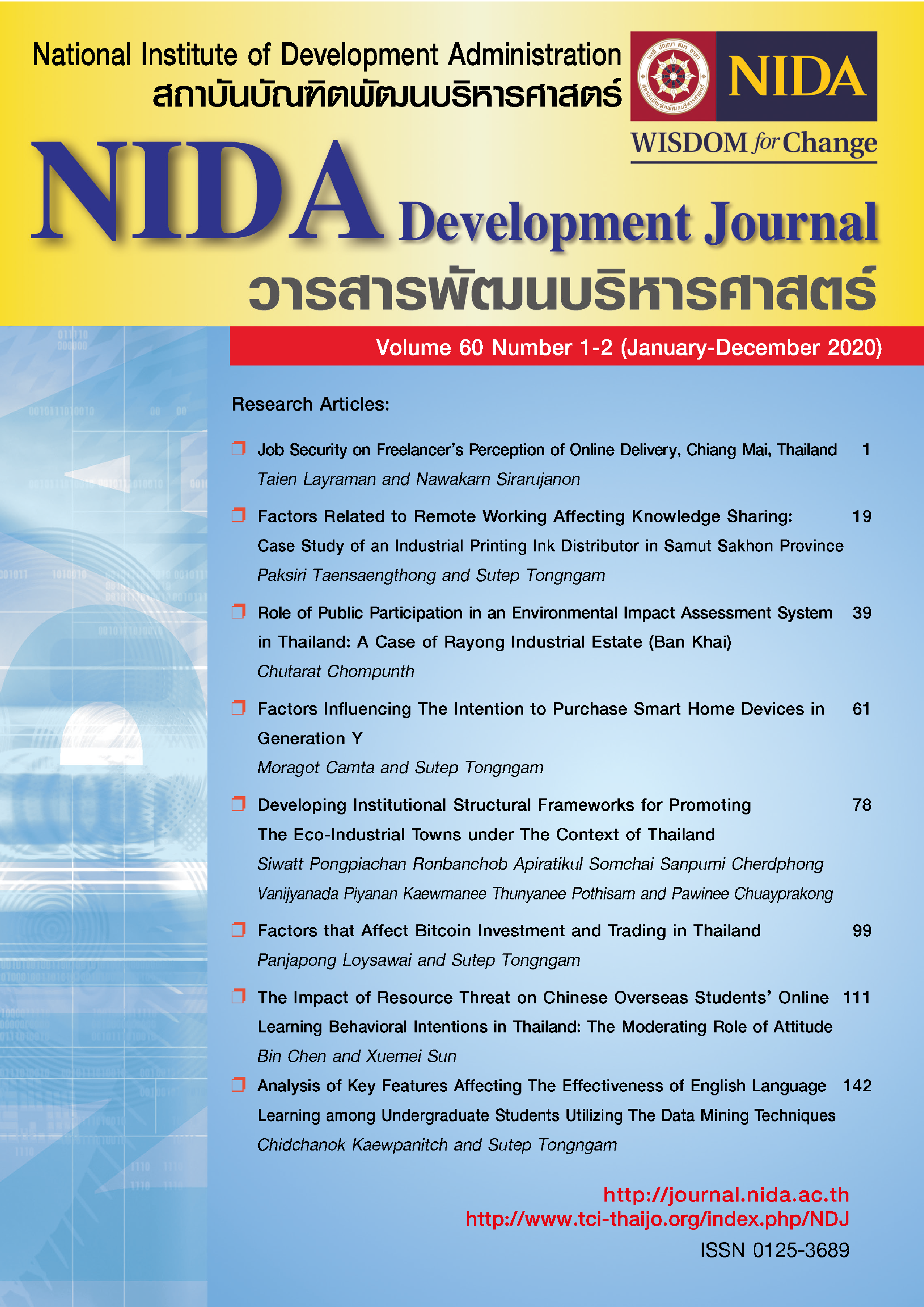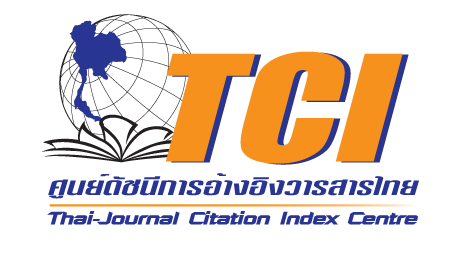Developing Institutional Structural Frameworks for Promoting The Eco-Industrial Towns under The Context of Thailand
Keywords:
Eco-Industrial Town (EIT), Big-Circular-Green (BCG), the Local Administrative Organizations (LAOs), Institutional Framework, Resource Efficiency & Cleaner Production (RECP)Abstract
This paper explores the development of institutional structural frameworks for promoting eco-industrial towns in the context of Thailand. Eco-industrial towns are sustainable development models that aim to integrate industrial activities with environmental stewardship and social well-being. The study examines the unique challenges and opportunities in Thailand and proposes a comprehensive framework to facilitate the establishment and successful operation of eco-industrial towns. The research identifies the need for a holistic approach that balances economic growth, environmental protection, and community engagement. Drawing on international best practices and lessons learned from existing eco-industrial towns worldwide, the paper presents a conceptual framework tailored to the Thai context. The proposed institutional structural framework comprises several key elements. First, it emphasizes the establishment of a dedicated regulatory and policy framework that incentivizes sustainable practices and sets clear environmental and social performance standards. Second, it promotes the formation of partnerships among various stakeholders, including government agencies, industries, local communities, and non-governmental organizations, to foster collaboration and knowledge exchange. Furthermore, the framework highlights the importance of capacity building and knowledge dissemination to enhance understanding and implementation of eco-industrial principles. It suggests the establishment of training programs, research institutes, and platforms for sharing best practices and technological innovations. Additionally, the involvement of financial institutions and mechanisms to facilitate access to capital for eco-industrial projects is underscored.
References
Aqlan, B., Himdi, M., Vettikalladi, H., & Le-Coq, L. (2021). A 300-GHz low-cost high-gain fully metallic Fabry–Perot cavity antenna for 6G terahertz wireless communications. Scientific Reports, 11(1), 1-9.
Beers, D. v., Meylan, F., Flammini, A., & Burrell, L. (2019). Eco-Industrial Parks: Achievements and Key Insights From The Global Recp Programme 2012 – 2018. Swiss Confederation.
Berkel, R. V. (2016). Productivity and innovation in food value chains through Resource Efficient and Cleaner Production (RECP). Paper presented at the 12th Asia Pacific Roundtable on Sustainable Consumption and Production, Siem Reap, Cambodia.
Castelli, P. A. (2016). Reflective leadership review: A framework for improving organisational performance. Journal of Management Development, 35(2), 217-236.
ChooChuay, C., Pongpiachan, S., Tipmanee, D., Deelaman, W., Iadtem, N., Suttinun, O., ... & Cao, J. (2020a). Effects of agricultural waste burning on PM2.5-bound polycyclic aromatic hydrocarbons, carbonaceous compositions, and water-soluble ionic species in the ambient air of Chiang-Mai, Thailand. Polycyclic Aromatic Compounds, 1-22.
ChooChuay, C., Pongpiachan, S., Tipmanee, D., Suttinun, O., Deelaman, W., Wang, Q., ... & Cao, J. (2020b). Impacts of PM2.5 sources on variations in particulate chemical compounds in ambient air of Bangkok, Thailand. Atmospheric Pollution Research, 11(9), 1657-1667.
ChooChuay, C., Pongpiachan, S., Tipmanee, D., Deelaman, W., Suttinun, O., Wang, Q., ... & Cao, J. (2020c). Long-range transboundary atmospheric transport of polycyclic aromatic hydrocarbons, carbonaceous compositions, and water-soluble ionic species in southern Thailand. Aerosol and Air Quality Research, 20(7), 1591-1606.
Creutzig, F. (2019). The mitigation trinity: Coordinating policies to escalate climate mitigation. One Earth, 1(1), 76-85. doi:https://doi.org/10.1016/j.oneear.2019.08.007
Cybersecurity Ventures. (2019). 2019 official annual cybercrime report: Cybercriminal activity is one of the biggest challenges that humanity will face in the next two decades.
Deigh, L., Farquhar, J., Palazzo, M., & Siano, A. (2016). Corporate social responsibility: Engaging the community. Qualitative Market Research: An International Journal.
Faria, E., Caldeira-Pires, A., & Barreto, C. (2021). Social, economic, and institutional configurations of the industrial symbiosis process: A comparative analysis of the literature and a proposed theoretical and analytical framework. Sustainability, 13(13), 7123. https://doi.org/10.3390/su13137123
Farshid, M., Paschen, J., Eriksson, T., & Kietzmann, J. (2018). Go boldly!: Explore augmented reality (AR), virtual reality (VR), and mixed reality (MR) for business. Business Horizons, 61(5), 657-663.
Gillingham, K., & Sweeney, J. (2012). Barriers to implementing low-carbon technologies. Climate Change Economics, 3(04), 1250019.
Green network. (2564). กระทรวงอุตสาหกรรมยกระดับโรงงานสู่สังคมคาร์บอนต่ำนำร่องเมืองอุตสาหกรรมเชิงนิเวศสมุทรปราการ. https://www.greennetworkthailand.comโรงงาน-คาร์บอนต่ำ/
Guo, J.-X., Zhu, K., Tan, X., & Gu, B. (2021). Low-carbon technology development under multiple adoption risks. Technological Forecasting and Social Change, 172, 121011. doi:https://doi.org/10.1016/j.techfore.2021.121011
Guo, Y., Li, S., Tawatsupa, B., Punnasiri, K., Jaakkola, J. J., & Williams, G. (2014). The association between air pollution and mortality in Thailand. Scientific Reports, 4(1), 1-8.
Hall, N. L., & Jeanneret, T. (2015). Social licence to operate: An opportunity to enhance CSR for deeper communication and engagement. Corporate Communications: An International Journal, 20(2), 213-227.
Hallegatte, S., Fay, M., & Vogt-Schilb, A. (2013). Green industrial policies: When and how. The World Bank.
Imperial, M. T. (2021). Implementation structures: The use of top-down and bottom-up approaches to policy implementation. In Oxford research encyclopedia of politics.
Jackson, E. A., & Jackson, H. F. (2017). The role of corporate social responsibility in improving firms’ business in the directions of sustainable development, accountability and transparency. African Journal of Economic and Sustainable Development, 6(2-3), 105-118.
Li, D. (2019). 5G and intelligence medicine—how the next generation of wireless technology will reconstruct healthcare?. Precision Clinical Medicine, 2(4), 205-208.
Mao, S., Wang, B., Tang, Y., & Qian, F. (2019). Opportunities and challenges of artificial intelligence for green manufacturing in the process industry. Engineering, 5(6), 995-1002.
Marmita, S. (2020). Struggle of ASEAN in cyber security. Asia and Africa Today, (8), 52-56.
Nakatani, Y. (2005). The effects of awareness‐raising training on oral communication strategy use. The Modern Language Journal, 89(1), 76-91.
Nawaz, Z. A. K. D. A., & Khan, I. (2016). Leadership theories and styles: A literature review. Leadership, 16(1), 1-7.
Ockwell, D., & Mallett, A. (2012). Low-carbon technology transfer. Routledge.
Ortega-Rodríguez, C., Licerán-Gutiérrez, A., & Moreno-Albarracín, A. L. (2020). Transparency as a key element in accountability in non-profit organizations: A systematic literature review. Sustainability, 12(14), 5834.
Phosri, A., Ueda, K., Phung, V. L. H., Tawatsupa, B., Honda, A., & Takano, H. (2019). Effects of ambient air pollution on daily hospital admissions for respiratory and cardiovascular diseases in Bangkok, Thailand. Science of the Total Environment, 651, 1144-1153.
Pongpiachan, S., Hattayanone, M., Choochuay, C., Mekmok, R., Wuttijak, N., & Ketratanakul, A. (2015). Enhanced PM10 bounded PAHs from shipping emissions. Atmospheric Environment, 108, 13-19.
Pongpiachan, S. (2016). Incremental lifetime cancer risk of PM2.5 bound polycyclic aromatic hydrocarbons (PAHs) before and after the wildland fire episode. Aerosol and Air Quality Research, 16(11), 2907-2919.
Pongpiachan, S., Hattayanone, M., & Cao, J. (2017). Effect of agricultural waste burning season on PM2.5-bound polycyclic aromatic hydrocarbon (PAH) levels in Northern Thailand. Atmospheric Pollution Research, 8(6), 1069-1080.
Pongpiachan, S., Jearanaikoon, N., Thumanu, K., Pradubsri, J., Supruangnet, R., Tharasawatpipat, C., ... & Apiratiku, R. (2021). Using synchrotron radiation X-ray fluorescence (SRXRF) to assess the impacts of shipping emissions on the variations of PM10-bound elemental species. Aerosol and Air Quality Research, 21, 210030.
Rangan, K., Chase, L., & Karim, S. (2015). The truth about CSR. Harvard Business Review, 93(1/2), 40-49.
Reijnders, L. (2003). Policies influencing cleaner production: The role of prices and regulation. Journal of Cleaner Production, 11(3), 333-338. doi:https://doi.org/10.1016/S0959-6526(02)00027-6
Rotheroe, N., & Richards, A. (2007). Social return on investment and social enterprise: Transparent accountability for sustainable development. Social Enterprise Journal, 3(1), 31-48.
Sabatier, P. A. (1986). Top-down and bottom-up approaches to implementation research: A critical analysis and suggested synthesis. Journal of Public Policy, 6(1), 21-48.
Seesung, W., Limsumlitnipa, T., Jitprapai, N., Kheokao, J., Patchimnan, M., & Krirkgulthorn, T. (2021). Media kxposure and Knowledge of the BCG Model economic development policy of the Thai people. Jurnal Komunikasi Pembangunan, 19(02).
Senthiil, P. V., Sirusshti, V. A., & Sathish, T. (2019). Artificial intelligence based green manufacturability quantification of a unit production process. International Journal of Mechanical and Production Engineering Research and Development, 9(2), 841-852.
UNIDO and UNEP. (2009). Joint UNIDO-UNEP Programme on Resource Efficient and Cleaner Production in Developing and Transition Countries. Retrieved from https://www.unido.org/sites/default/files/2010-04/RECP%20Programme%20Flyer%20April%202010%20(2)_0.pdf
UNIDO. (2016). A low-carbon path to enhanced industrial competitiveness.
UNIDO. (2017). Implementation handbook for eco-industrial parks: United Nations Industrial Development Organization.
UNIDO. (2021). Resource Efficient and Cleaner Production (RECP). Retrieved from https://www.unido.org/our-focus-safeguarding-environment-resource-efficient-and-low-carbon-industrial-production/resource-efficient-and-cleaner-production-recp
Vichit-Vadakan, N., & Vajanapoom, N. (2011). Health impact from air pollution in Thailand: Current and future challenges. Environmental Health Perspectives, 119(5), A197-A198.
Ye, X., Zhao, B., Nguyen, T. H., & Wang, S. (2020). Social media and social awareness. In Manual of digital earth
Downloads
Published
How to Cite
Issue
Section
License
Copyright (c) 2024 NIDA Development Journal

This work is licensed under a Creative Commons Attribution-NonCommercial-NoDerivatives 4.0 International License.





